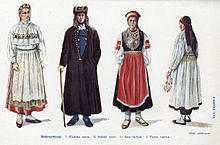Estonian National Museum
The Estonian National Museum ( Estonian Eesti Rahva Muuseum - ERM) is located in Tartu, South Estonia . It includes the world's most important collection on Estonian folk culture and the rural roots of the Estonian people . At the same time, it is an ethnological research center and often invites you to lectures, colloquia and conferences on Estonian folklore.
history
The National Museum was founded in 1909 in Tartu (German Dorpat ) in Livonia, still under tsarist rule. The aim was to contribute to the collection and preservation of Estonian folk culture.
The museum is dedicated to the legacy of the Estonian folklorist Jakob Hurt (1839–1907), one of the most important early collectors of Estonian folk art. The collection of ethnographic objects from the second half of the 19th century formed the basis of today's museum. One of the initiators of the establishment of the Estonian National Museum was the Estonian diplomat, folklorist and linguist Oskar Kallas (1868-1946).
In 1913, four years after its foundation, the city of Tartu made the museum's first suitable premises available. In 1922, the museum moved into a representative mansion in the Raadi district of Tartu and hired a permanently paid director. The first permanent exhibition was opened in 1923.
During the Second World War , the main building of the museum was badly damaged by a Soviet bombing raid in 1944. It served as accommodation for the Red Army during the Soviet occupation of Estonia . The museum itself moved to downtown Tartu and was reopened as the "State Ethnographic Museum of the Estonian SSR " ( Eesti NSV Riiklik Etnograafiamuuseum ). The collections themselves were housed in different buildings throughout the city. In 1988, under the sign of glasnost and perestroika , the Estonian National Museum got its original name back.
On the site of the former Soviet Raadi airfield , a new building was built from 2009 based on a design by the Parisian architecture firm Dorell Ghomtmeh Tane . The new museum was opened by President Toomas Hendrik Ilves on September 29, 2016.
collection
The museum comprehensively presents the history, way of life and traditions of the Estonians and other Finno-Ugric peoples, as well as the national minorities living in Estonia.
The new museum is - like the old one - primarily a folklore museum. The main part of the permanent exhibition, entitled “Encounters”, shows the Estonian culture, among others. a. the rich songs, in particular the Runo singing , the rural customs , the rural festivals and holidays, the traditional handicrafts and handicrafts, costumes from all regions of the country as well as around 3,000 photographs by Johannes Pääsuke showing life in the country between 1908 and 1918 document. Using the example of the fate of individual people, the museum also presents the history of Estonia in the decades of the Soviet occupation and their efforts to Russify the Estonian people .
The second part of the permanent exhibition, entitled “Echo of the Urals ”, is dedicated to the diversity of cultures, languages and stories of the Finno-Ugric peoples on both sides of the Ural Mountains.
Web links
Individual evidence
- ↑ Eesti Muuseumiühing: Eesti Muuseumid. Tallinn 2003, p. 180
- ↑ a b c Cornelius Wüllenkemper: Gigantic glass launch pad into the future. The new Estonian National Museum opens in Tartu on the site of the former military airport. In: Frankfurter Allgemeine Zeitung of October 11, 2016, p. 12.
- ^ Echo of the Urals , accessed October 20, 2016.
Coordinates: 58 ° 23 ′ 44.3 " N , 26 ° 44 ′ 44.1" E



